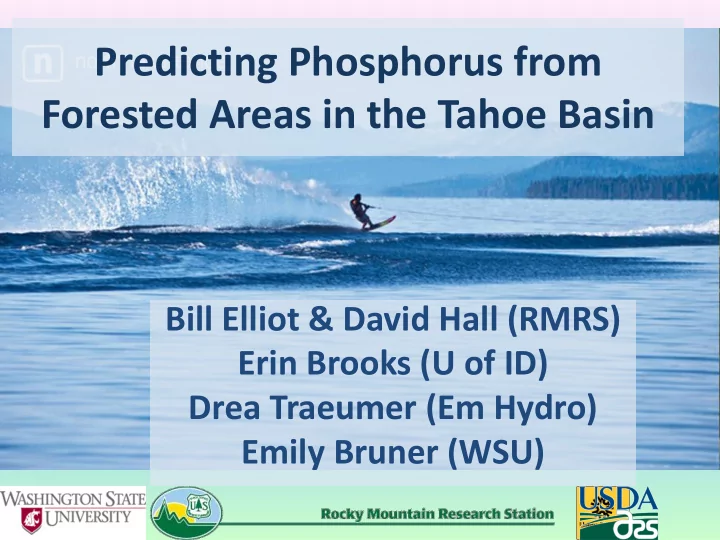

Predicting Phosphorus from Forested Areas in the Tahoe Basin Bill Elliot & David Hall (RMRS) Erin Brooks (U of ID) Drea Traeumer (Em Hydro) Emily Bruner (WSU)
Outline • A bit of background • Phosphorus pathways • WEPP Hydrologic Framework • Modeling Phosphorus delivery with WEPP 2
Why worry about Phosphorus Prediction? • Lake Tahoe clarity is important to many • An increase in phosphorus leads to an increase in algal growth • An increase in algal growth leads to a decrease in lake clarity 3
Why worry about Phosphorus Prediction? • Lake Tahoe clarity is a important to many • An increase in phosphorus leads to an increase in algal growth • An increase in algal growth leads to a decrease in lake clarity • If we can predict phosphorus delivery associated with forest management, we can evaluate alternative management practices to reduce delivery 4
Why worry about forests? • Generally, P delivery is associated with human activity • Forest covers > 80% Land Ownership, in Basin LTBMU of basin State of California State of Nevada Local government Private 5
Why worry about forests? • Generally, P delivery is associated with human activity • Forest covers > 80% of basin • With the increased need to reduce fire risk in basin, fuel management activities are increasing 6
Why worry about forests? • Generally, P delivery is associated with human activity • Forest covers > 80% of basin • With the increased need to reduce fire risk in basin, fuel management activities are increasing • What are the effects of different forest management practices on P delivery? 7
How Does P get from forestland to the water? • Surface Runoff – Generally from roads or after wildfire 8
How Does P get from the land to the water? • Surface Runoff • Eroded sediments 9
How Does P get from the land to the water? • Surface Runoff • Eroded sediments • Subsurface Lateral Flow • Groundwater Precipitation or melting snow Evapotranspiration Snow Interception & Sublimation Infiltration Surface Runoff Deep Seepage Shading Lateral Flow 10 Groundwater Base Flow
Some Typical P Concentrations: Surface Processes: Sediment Source P Concentration Rainfall Simulation Observed Sediment Granitic 4 – 22 mg/kg 475 mg/kg Volcanic 9 – 13 mg/kg 159 mg/kg Alluvial 333 mg/kg Suspended sediment 1500 – 4500 mg/kg Note that for suspended sediment, the “fines,” carry the P 11
Some Typical P Concentrations: Surface Processes: Runoff Source P Concentration Rainfall Simulation Observed Sediment Granitic 4 – 22 mg/kg 475 mg/kg Volcanic 9 – 13 mg/kg 159 mg/kg Alluvial 333 mg/kg Suspended sediment 1500 – 4500 mg/kg Surface Runoff Snow melt 0.05 – 0.3 mg/l, typically 0.09 Simulation Study Volcanic 1.28 mg/l Granitic 0.89 mg/l Alluvial 0.25 mg/l Note that snowmelt concentrations lower than simulation 12
Some Typical P Concentrations: Subsurface Processes Source P Concentration Soil Water @ depth 0 - 5 cm 4 - 10 mg/l 5 – 20 7.8 mg/l 20 – 50 0.02 – 5.6 mg/l > 50 3.6 mg/l Nr Moscow ~130 cm 0.4 – 1.4 mg/l Interflow 0.002 – 11.1 (Median 4.3) mg/l Base Flow 0.008 – 0.125 mg/l Comments: High variability Wally said this would be interesting 13
Some Typical P Concentrations: Runoff & Management Source P Concentration mg/1000 cm 2 Surface/Interflow runoff 0.02 Undisturbed Harvested 0.01 Burned, no harvest 0.01 Harvest and burn 0.01 Question: Is there a nutrient buildup in fire-suppressed forests? What about those concentration units? 14
Some Typical P Concentrations: Runoff & Management Source P Concentration Surface/Interflow runoff Undisturbed 0.02 mg/l Harvested 0.01 Burned, no harvest 0.01 Harvest and burn 0.01 Jackpot burn simulator runoff Forest 0.37 mg/l Unmopped pile 2.15 mg/l Mopped pile 0.36 mg/l Comment: “Mopping” a burn pile may be a good idea… 15
WEPP Hydrologic Framework • WEPP does a daily water balance – Precipitation, snow melt, infiltration and runoff – Evapotranspiration – Soil water content – Lateral flow – Deep seepage 16
WEPP Hydrologic Framework • WEPP does a daily water balance – Precipitation, snow melt, infiltration and runoff – Evapotranspiration – Soil water content – Lateral flow – Deep seepage • For runoff events – Rill and interrill erosion – Sediment delivery with surface area enrichment 17
To predict P Delivery, we have tapped into specific WEPP outputs • WEPP does a daily water balance – Runoff – Lateral flow – Deep seepage for linear flow model • For runoff events – Sediment delivery – Surface area enrichment 18
The Prototype Interface • Input fields are being added – Fine sediment – P concentrations 19
The Output Lateral flow dominant pathway for P delivery (Observed 0.04 – 1 lb/a) 20
What about the Base Flow? • Necessary for modeling watershed processes • The Brooks Linear Flow Model: – Sponge and leaky tub, or – Soil => temporary reservoir => base flow and losses 21
What about the Base Flow? • The Brooks Linear Flow Model: – Set up a dynamic groundwater reservoir – Recharge with deep seepage – Every day: Base flow = K1 x depth in reservoir, and Groundwater losses = K2 x depth in reservoir 22
Base Plus Surface and Lateral Flow • Adding it all up: runoff hydrograph • P graph will follow 23
Questions or Comments? 24
Recommend
More recommend